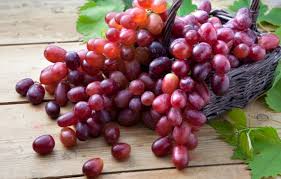Grapes fruit which is scientifically known as Vitis vinifera are small, juicy fruits that grow on vines. These vines can be found in many parts of the world, and grapes come in various colors, including red, green, and purple. One fascinating thing about grapes is that they can be enjoyed in different forms, such as fresh, dried, or as a refreshing beverage – grape juice or wine.
When you bite into a grape, you experience a burst of sweet flavor. Grapes are not just delicious; they also offer numerous health benefits. They are rich in antioxidants, which help protect our cells from damage. Additionally, grapes contain vitamins like vitamin C and K, contributing to a healthy immune system and proper blood clotting.
Grapes have been cultivated for thousands of years, with evidence of their consumption dating back to ancient civilizations. The process of growing grapes involves careful attention to the vine, ensuring it receives the right amount of sunlight and water. Grapes are often grown in vineyards, where rows of vines create a picturesque landscape.
One of the most well-known products derived from grapes is wine. The process of making wine involves fermenting crushed grapes, and the resulting beverage comes in various types and flavors. Wine has become a significant part of many cultures, with people enjoying it during celebrations, meals, and social gatherings.
Aside from their culinary uses, grapes also find their way into various cultural and religious practices. They are often associated with symbolism, representing abundance, fertility, and prosperity in different traditions.
In addition to being consumed fresh, grapes can be dried to make raisins. Raisins are a popular snack and are often used in baking and cooking. Drying grapes concentrates their natural sugars, creating a chewy and sweet treat.
Grapes play a crucial role in the economy of regions where they are grown. The cultivation of grapes provides employment opportunities and contributes to the livelihoods of many people. The grape industry involves not only the production of fresh grapes but also the manufacturing of products like grape juice, wine, and grape-based snacks.
In addition, grapes are versatile fruits that offer a delightful taste and a range of health benefits. From fresh grapes to raisins and wine, these small fruits have made their mark in various culinary and cultural contexts. Their cultivation has created thriving industries, and their consumption continues to be a cherished part of human life.
Read Also: Types of Wild Dogs and their Characteristics
History of Grapes (Vitis vinifera)

Grapes have a rich history that spans thousands of years. They are believed to have originated in the region of present-day Iran and have been cultivated since ancient times. Archaeological evidence suggests that grapes were consumed by early civilizations, including the Egyptians, Greeks, and Romans.
In ancient Greece, grapes were associated with the god Dionysus, who was the deity of wine, fertility, and revelry. The Greeks were among the first to cultivate grapes for winemaking, and this practice spread throughout the Mediterranean region.
The Romans, too, embraced the cultivation of grapes and the art of winemaking. They expanded vineyards across their vast empire and incorporated wine into their daily lives, religious ceremonies, and social gatherings. The Roman influence on grape cultivation and winemaking laid the foundation for the development of European wine culture.
As the Roman Empire declined, monasteries in medieval Europe played a significant role in preserving and advancing the knowledge of grape cultivation and winemaking. Monks carefully tended to vineyards, contributing to the continuity of the grape-growing tradition.
During the Age of Exploration, European colonists brought grapevines to the Americas, introducing them to regions like California and South America. This led to the establishment of vineyards in the New World, further diversifying the varieties of grapes cultivated globally.
In the 19th century, the development of transportation, especially the railroad, facilitated the distribution of grapes and wine to wider markets. This era marked the commercialization of the grape industry, with vineyards becoming an integral part of agriculture in many regions.
In the 20th century, technological advancements in viticulture and winemaking further transformed the grape industry. Innovations such as refrigeration and better transportation methods allowed grapes to be transported over longer distances, making fresh grapes and grape products accessible to people around the world.
Today, grapes are grown on every continent except Antarctica, showcasing their adaptability to various climates. The global grape industry continues to thrive, with a diverse array of grape varieties, each offering unique flavors and characteristics.
The history of grapes is intertwined with the development of human civilizations, from ancient times to the present day. The cultivation and appreciation of grapes have evolved over the centuries, leaving an enduring legacy in the form of vineyards, winemaking traditions, and a global industry centered around these versatile fruits.
Nutritional Value of Grapes (Vitis vinifera)

Grapes are not only delicious but also pack a punch of nutritional benefits. Here’s a glimpse into the nutritional values of these tiny, flavorful fruits:
1. Calories: Grapes are relatively low in calories, making them a healthy snack option. A cup of grapes typically contains around 100 calories.
2. Carbohydrates: Grapes are rich in carbohydrates, mainly in the form of natural sugars like glucose and fructose. These sugars provide a quick energy boost.
3. Fiber: Grapes contain dietary fiber, which is beneficial for digestive health. Fiber helps regulate bowel movements and supports a healthy gut.
4. Vitamins: Grapes are a good source of essential vitamins, including vitamin C, vitamin K, and various B vitamins. Vitamin C is an antioxidant that boosts the immune system, while vitamin K is important for blood clotting.
5. Minerals: Grapes contain minerals such as potassium, magnesium, and copper. Potassium helps regulate blood pressure, magnesium supports muscle and nerve function, and copper plays a role in the formation of red blood cells.
6. Antioxidants: Grapes are loaded with antioxidants, including resveratrol, flavonoids, and quercetin. These compounds help protect cells from oxidative stress and may contribute to overall health.
7. Hydration: Grapes have a high water content, contributing to hydration. Staying hydrated is essential for various bodily functions, including temperature regulation and nutrient transport.
8. Phytonutrients: Grapes contain phytonutrients, which are natural compounds that have been associated with various health benefits. Resveratrol, in particular, has gained attention for its potential heart-protective properties.
It’s important to note that the specific nutritional content can vary slightly depending on the grape variety, whether they are red, green, or black, and how they are prepared (fresh, dried, or in the form of juice or wine). Including a variety of fruits, including grapes, in a balanced diet contributes to overall health and well-being.
Read Also: All You Need to Know About the Painted African Dog
Health Benefits of Grapes (Vitis vinifera)

Grapes offer a range of health benefits, making them a nutritious addition to your diet. Here are some of the notable health benefits associated with the consumption of grapes:
1. Heart Health: Grapes contain antioxidants like resveratrol, which may contribute to heart health by reducing inflammation and supporting healthy blood vessels. The fiber and potassium content in grapes also play a role in maintaining cardiovascular well-being.
2. Blood Pressure Regulation: The potassium content in grapes helps regulate blood pressure by balancing the effects of sodium in the body. Maintaining a healthy blood pressure is crucial for cardiovascular health.
3. Antioxidant Protection: Grapes are rich in antioxidants, including flavonoids and quercetin, which help neutralize harmful free radicals in the body. This antioxidant activity may contribute to the prevention of chronic diseases and support overall well-being.
4. Immune Support: The vitamin C content in grapes boosts the immune system, helping the body defend against infections and illnesses. Regular consumption of grapes can contribute to a stronger immune response.
5. Digestive Health: The fiber content in grapes supports digestive health by promoting regular bowel movements and preventing constipation. A healthy digestive system is essential for nutrient absorption and overall well-being.
6. Respiratory Health: Certain compounds in grapes have been linked to improved lung function and reduced risk of respiratory conditions. The antioxidants in grapes may help protect the lungs from oxidative damage.
7. Cancer Prevention: Some studies suggest that the antioxidants in grapes, particularly resveratrol, may have anticancer properties. These compounds may help inhibit the growth of cancer cells and reduce the risk of certain cancers.
8. Brain Health: Resveratrol, found in grapes, has been associated with cognitive benefits. It may help protect the brain from age-related decline and contribute to better memory and cognitive function.
9. Hydration: Grapes have a high water content, contributing to hydration. Proper hydration is essential for various bodily functions, including maintaining skin health, regulating body temperature, and supporting overall well-being.
10. Weight Management: Grapes are a satisfying and low-calorie snack, making them a healthy choice for those aiming to manage or lose weight. The fiber content also helps promote a feeling of fullness.
Incorporating a variety of grapes into your diet, along with other fruits and vegetables, can contribute to a well-rounded and healthful eating pattern. As with any food, moderation is key, and it’s essential to maintain a balanced and varied diet for optimal health.
How to Grow Grapes

Growing grapes can be a rewarding endeavor, whether you’re planning to cultivate them for fresh consumption or for winemaking. Here’s a basic guide on how to grow grapes:
1. Choose the Right Variety: Select a grape variety that suits your climate. Grapes are classified into American, European, and hybrid varieties, each adapted to different growing conditions.
2. Select a Suitable Location: Grapes thrive in well-drained soil with good sun exposure. Choose a location with full sunlight, preferably on a slope to aid drainage.
3. Soil Preparation: Test the soil to ensure it has a pH level between 6.0 and 6.5, which is ideal for grape cultivation. Improve soil fertility by adding organic matter like compost.
4. Planting: Plant grapevines in the early spring or late fall, when they are dormant. Space the vines according to the specific variety requirements.
5. Trellis System: Grapes benefit from a trellis system to support the vines, promote air circulation, and make harvesting easier. Install sturdy trellises or arbors.
6. Pruning: Pruning is crucial for grapevines. Prune in late winter or early spring to remove dead or weak growth and encourage the development of strong, fruitful canes.
7. Watering: Grapes need regular watering, especially during dry periods. However, it’s important not to overwater, as grapevines are susceptible to root diseases.
8. Fertilization: Apply a balanced fertilizer in the spring to provide necessary nutrients. Avoid excessive nitrogen, which can lead to excessive foliage growth at the expense of fruit production.
9. Pest and Disease Management: Keep an eye out for pests like aphids and diseases like powdery mildew. Regular inspection and appropriate treatments, including organic options, can help manage these issues.
10. Harvesting: Grapes are typically ready for harvest in late summer or early fall. The exact timing depends on the grape variety. Harvest when the grapes are fully ripe, as they do not ripen further after picking.
11. Post-Harvest Care: After harvesting, prune the vines to remove old wood and maintain plant health. Consider covering young vines during the winter to protect them from harsh weather.
Remember, local climate and soil conditions play a significant role in grape cultivation. Consult with local agricultural extension services or grape-growing experts to tailor your approach to the specific conditions in your area. Patience and consistent care are key to a successful grape-growing experience.
Read Also: Water and Waste-water Purification Process
